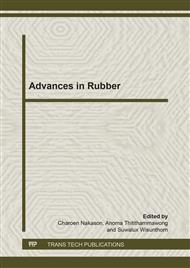p.154
p.158
p.162
p.166
p.170
p.174
p.178
p.182
p.186
Modulation of Drug Release from Natural Rubber Coated Capsule Loaded with Sodium Bicarbonate and Camphor
Abstract:
Natural rubber (NR) has the distinguished film forming and hydrophobic properties. If it could be reformed by an addition of some pore forming agents, the porous topography of this produced material would be interesting for applying in controlled release system. The purpose of this study is to investigate on characterization of film coat and release of propranolol hydrochloride (P) from capsules coated with NR latex. The experimental methods involved the preparation of NR film which was optimally prepared by dipping technique followed by drying onto hard gelatin capsule. The drug release was determined for coated systems fabricated with two different techniques (the dissolving of sodium bicarbonate and the sublimation of ammonium carbonate or camphor). It indicated that ammonium carbonate was incompatible with NR latex. The extent of overall in vitro release of P into HCl buffer pH 1.2 from plain NR film coated capsule at 8 h was approximately 1%. However, the decrease concentration of NR latex or addition of sodium bicarbonate or camphor could enhance the extent of drug release. Scanning electron microscopy (SEM) exhibited the micro porous nature for systems loaded with sodium bicarbonate or camphor. Therefore the hydrophobic nature of NR was proper for sustainable drug release which an incorporation of some poring agent could modulate the release of active compounds.
Info:
Periodical:
Pages:
170-173
Citation:
Online since:
November 2013
Authors:
Keywords:
Price:
Сopyright:
© 2014 Trans Tech Publications Ltd. All Rights Reserved
Share:
Citation:


